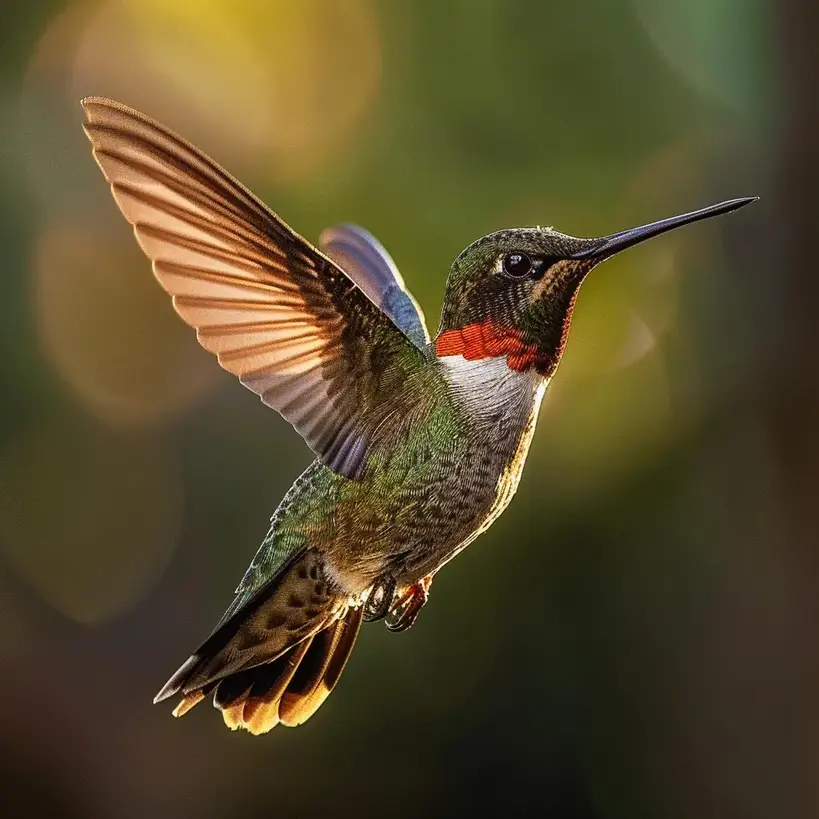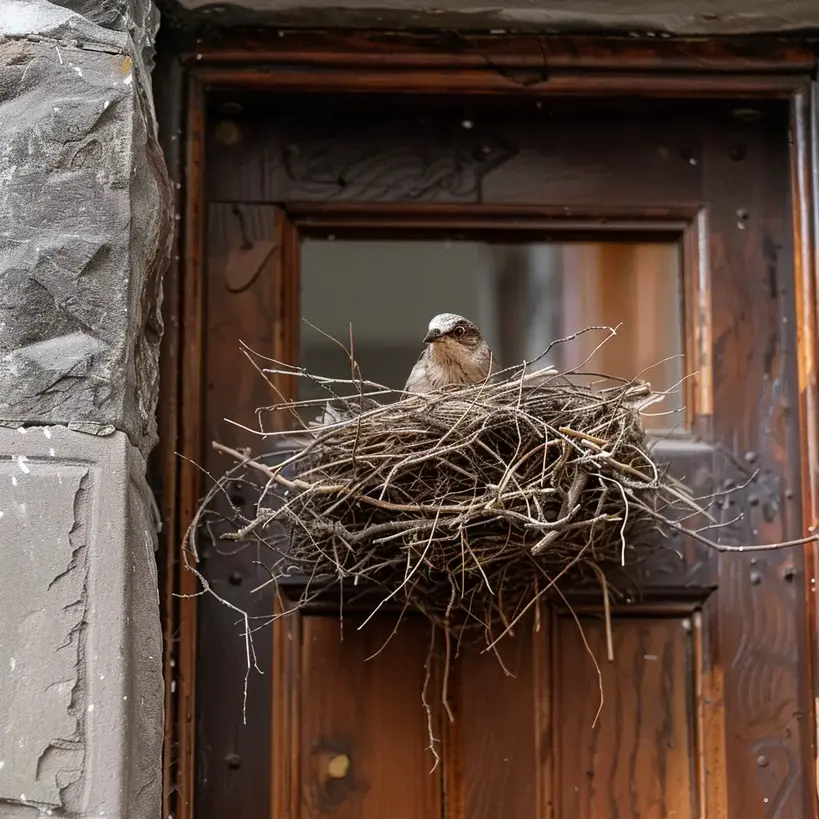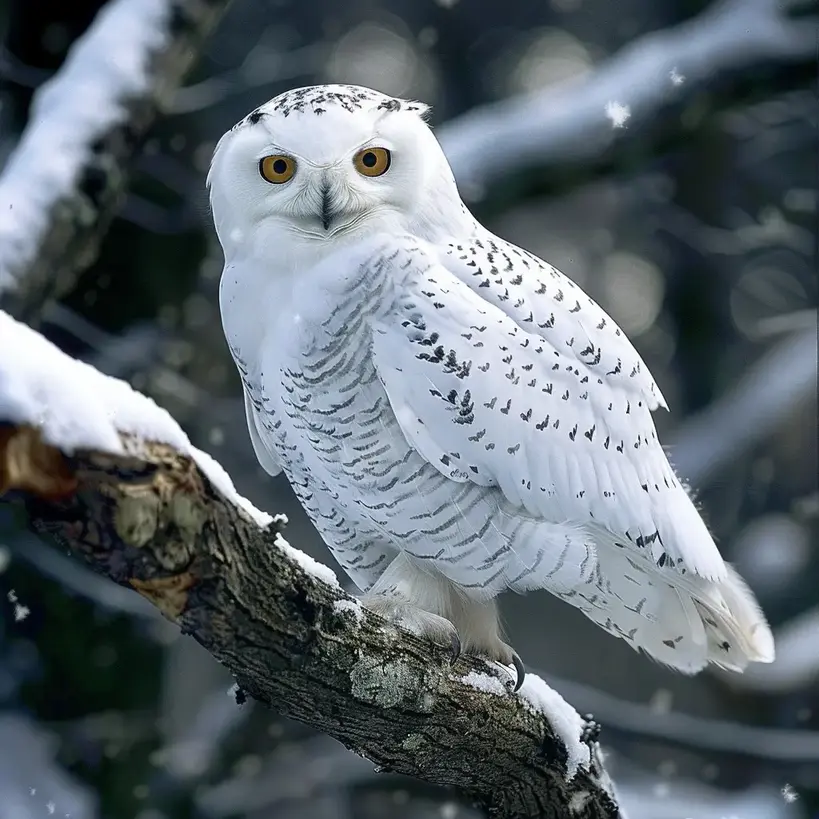The crow, a bird that evokes a mixture of intrigue and mystery across various cultures, has earned its place in numerous tales, myths, and religious texts throughout history. In the Bible, a tome rich in symbols and allegories, the crow—and its close relative, the raven—hold unique and multifaceted roles.
From their representation in Old Testament narratives to their brief, yet profound, appearances in the New Testament teachings, these birds challenge simplistic interpretations. They navigate the space between the divine and the earthly, serving as both messengers and symbols and beckoning readers to dive deeper into their biblical significance.
This exploration delves into the varied representations of the crow in the Bible, seeking to uncover the layers of meaning behind this enigmatic avian figure.
Contents
1. Crows in Genesis: Noah’s Uncelebrated Messenger
While the dove often takes center stage in the tale of Noah’s Ark as the harbinger of hope, the crow—or more specifically, its close relative, the raven—plays a significant yet often overlooked role in the narrative. Delving into the early chapters of Genesis, we find the raven dispatched before the dove, serving as the initial messenger sent out by Noah to gauge the receding of the floodwaters.
A. The Raven’s Mission:
In Genesis 8:6-7, after the floodwaters began to recede from the earth, Noah sent out a raven to see if the waters had gone down:
“And he sent forth a raven, which went forth to and fro, until the waters were dried up from off the earth.”
Unlike the dove, which returned with an olive branch and later found no place to set its foot, the raven did not return to the ark. This persistent going “to and fro” might imply that the earth, though emerging, was still not hospitable, and the raven had to fend for itself.
B. The Nature of Ravens and Crows
Ravens and crows are hardy and versatile creatures, capable of surviving in a variety of conditions. Their scavenger nature would have allowed them to find sustenance even amidst the detritus left by the receding floodwaters. This adaptability contrasts with the dove’s gentler nature and specific dietary habits, which would make it more dependent on specific conditions to survive.
C. Symbolic Interpretations
- Indicator of Desolation: The raven’s failure to return might symbolize that the earth was still a place of desolation and chaos. It hints at a world still in transition, not yet ready for the rebirth and renewal that the dove would later signify.
- Endurance Amidst Adversity: The raven’s adaptability can be seen as emblematic of endurance amidst hardship. Just as it braved the post-flood world, humanity too would have to demonstrate resilience in the face of the challenges awaiting them outside the ark.
- Transition from Judgment to Mercy: The raven can also symbolize God’s judgment – a stark, challenging period of cleansing, which is then followed by the dove, symbolizing God’s promise, mercy, and the hope of a new beginning.
The raven’s role in the Noahic narrative, while less celebrated than that of the dove, offers deep layers of meaning and symbolism. It bridges the transition between a world under judgment and a world ready for rebirth. Recognizing its significance allows for a richer understanding of the biblical narrative, where every creature, no matter how unassuming or overlooked, has a role to play in the unfolding of divine providence.
2. Providers During Desolation: The Story of Elijah
In the realm of biblical stories, certain narratives stand out for their deep layers of symbolism and timeless messages. One such story is that of Elijah, the prophet, who during a period of severe drought and famine was sustained by what many would consider an unlikely provider: ravens.
This narrative, rich with metaphors, can be found in the early verses of 1 Kings 17, and it sheds light on the unexpected ways in which divine providence operates, especially during times of desolation.
A. Setting the Stage: The Judgment on Israel
Elijah emerges as a significant prophetic figure during the reign of King Ahab, who, along with his notorious queen Jezebel, led Israel into rampant idolatry. In a bold proclamation, Elijah declares a drought as a divine judgment upon the land due to the people’s apostasy. This drought, which would last for years, brought with it widespread famine and suffering.
B. Ravens as Unexpected Providers
In the midst of this drought, God instructs Elijah to retreat to the Kerith Ravine, east of the Jordan. Here, in isolation, Elijah would be shielded from the wrath of King Ahab, who sought to kill him. However, this refuge also presented a dilemma: How would Elijah sustain himself in such barren conditions?
God commands the ravens to feed Elijah:
“The ravens brought him bread and meat in the morning, and bread and meat in the evening, and he drank from the brook” (1 Kings 17:6).
True to this promise, ravens brought him bread and meat every morning and evening.
In the biblical context, ravens are often associated with desolation, given their scavenger nature. Their status as ‘unclean’ birds according to Levitical laws further intensifies the surprise of their role here. Yet, in this desolate environment, they become instruments of God’s provision, ensuring the prophet’s sustenance.
C. Symbolic Interpretations
- God’s Sovereignty Over Creation: The obedience of the ravens underscores that all of creation, even the wild and ‘unclean,’ are under God’s dominion and can be used to fulfill His purposes.
- Unexpected Grace: Just as the ravens, often symbols of desolation, are used for provision, God often brings blessings and sustenance from the most unexpected sources, especially during our most challenging times.
- Reliance on Divine Provision: The narrative reinforces the idea that even in times of desolation and scarcity, those who obey and trust in God can rely on His provision. It’s a testament to the verse in Philippians 4:19: “And my God will meet all your needs according to the riches of his glory in Christ Jesus.”
- Reversal of Natural Roles: Ravens, typically scavengers benefiting from the demise of other creatures, are reversed in their roles here. Instead of taking life, they are now giving and sustaining life. It’s a powerful metaphor for God’s ability to invert situations and utilize even those elements seemingly opposed to His purposes.
The story of Elijah and the ravens is emblematic of God’s ceaseless care for His chosen ones, even in the harshest circumstances. The unlikely providers in this narrative — the ravens — serve as a powerful reminder that God’s ways often defy human logic, and His provision can come from the most unexpected sources.
3. The Unclean Nature: The Crow’s Status in Levitical Law
The Book of Leviticus, with its detailed guidelines on rituals, sacrifices, and purity laws, plays a crucial role in shaping the religious and societal framework of ancient Israel. The dietary restrictions provided in Leviticus were part of a broader framework aimed at setting the Israelites apart from neighboring nations.
A. Leviticus: A Book of Holiness and Separation
Leviticus 11 lays out comprehensive dietary laws for the Israelites, classifying various animals as either clean (permissible to eat) or unclean (forbidden). Verse 15 explicitly states, “every raven after its kind” is considered unclean.
Several factors might contribute to the crow’s “unclean” status:
- Dietary Habits: Crows are omnivorous scavengers, often feeding on carrion. Consuming the flesh of the dead made them unsuitable for consumption according to the dietary standards of ancient Israel, which had strict rules against contact with the dead or consumption of blood.
- Symbolism of Death: As scavengers, crows are often seen around decaying matter and dead animals. This association with death and decay could further their unclean status, as death and decomposition were seen as antithetical to the life-affirming attributes of God.
- Contrast with Holy Living: The detailed purity laws were designed to set Israel apart from surrounding nations, guiding them towards a life that was holy and distinct. Avoiding animals associated with death or scavenging behaviors symbolized a higher standard of living aligned with God’s commands.
B. The Larger Context of Levitical Laws
The classification of animals into clean and unclean categories was not merely about dietary restrictions but also carried spiritual overtones. Unclean animals symbolized impurity, chaos, and that which is not in alignment with God’s ideal order. In contrast, clean animals represented order, purity, and alignment with divine principles.
- Holiness and Separation: One of the overarching themes of Leviticus is the call to holiness. By abstaining from certain foods deemed unclean, the Israelites were continuously reminded of their sacred relationship with God and their duty to remain separate from the pagan practices surrounding them.
- Moral Lessons: Beyond the immediate dietary guidelines, the laws can be seen as a metaphorical guideline, teaching the Israelites to discern between the holy and the unholy in their moral and spiritual lives.
C. Modern Interpretations
While dietary laws played a role in daily life, their implications extended beyond food. They were symbolic of the moral and ethical choices the Israelites were to make. Just as they were to avoid certain foods, they were also to avoid behaviors and practices that were spiritually ‘unclean’ or detrimental.
While dietary laws played a role in daily life, their implications extended beyond food. They were symbolic of the moral and ethical choices the Israelites were to make. Just as they were to avoid certain foods, they were also to avoid behaviors and practices that were spiritually ‘unclean’ or detrimental
4. Symbols of God’s Care: Message in Luke
Ravens, as observed in nature, are not farmers or gatherers in the way humans are. They don’t sow seeds or store up harvests in barns. Yet, they always find sustenance. They survive and thrive, finding food day by day, despite their lack of human-like forethought or planning. This innate ability of the ravens to sustain themselves is not due to their effort but the ecological balance and provision designed by the Creator.
A. The Sermon on the Plain: A Testament to God’s All-encompassing Care
Jesus, in the New Testament, uses the example of the crow/raven to highlight God’s care for all His creatures, big or small:
“Consider the ravens: they neither sow nor reap, they have neither storehouse nor barn, and yet God feeds them. Of how much more value are you than the birds!“ - Luke 12:24
There, ravens become God’s chosen instrument, responsible for feeding the prophet during a time of drought and scarcity. In this instance, the raven becomes a symbol of God’s unexpected ways of provision, a testament to His sovereignty and care even in desolate situations.
By using ravens as an example, Jesus tackles a fundamental human fear: the fear of lack and the anxiety over tomorrow. The imagery here is potent. If God ensures the sustenance of a bird, often viewed with ambiguity in ancient Jewish culture, how much more will He care for human beings, His crowning creation?
B. Value and Worth in God’s Eyes
The crux of Jesus’ message in Luke 12:24 isn’t merely about God’s ability to provide but also a testament to human value in the eyes of the divine. By juxtaposing the life of a raven with human life, Jesus emphasizes the incomparable value humans have before God.
The Raven as a Symbol:
- Dependence on Divine Providence: The raven, in its daily reliance on finding food, epitomizes a life lived in dependence on God’s provision. They are a testament to a Creator who ensures that even the smallest and seemingly insignificant creatures find their daily sustenance.
- Challenging Human Anxiety: By pointing to the ravens, Jesus underscores the futility of human worry. If God ensures that these birds are fed, how much more will He provide for humans, who He created in His image?
- Affirmation of Human Value: Jesus’s rhetorical question, “Of how much more value are you than the birds?” reaffirms the unique value and worth of every individual. In God’s eyes, if He cares for the birds, surely His care for humanity is even greater.
C. A Call to Trust
The raven becomes not just a symbol of God’s care but a call to trust. A life lived in anxiety is contrasted with the carefree existence of the raven, urging believers to place their trust in God, knowing that He is attentive to their needs. This trust, as Jesus teaches, should liberate individuals from the shackles of worry, allowing them to live with the freedom and joy of birds in flight.
Crows: Harbingers or Protectors? A Dual Role in Biblical Narratives and Beyond
The crow, and its close relative the raven, have fascinated humans for millennia, carving out an enigmatic place in cultural, spiritual, and religious narratives worldwide. Their dark feathers, sharp eyes, and distinctive calls often conjure images of mystery, magic, and even malice. But is their role strictly that of a harbinger of doom? Or could they also be seen as protectors or even divine messengers? The biblical narrative and broader cultural interpretations provide some compelling insights.
A. The Crow as Harbinger:
- Omens of Change: Their appearance, often before significant events or shifts, has caused many to view crows as portents. This is not unique to Judeo-Christian traditions; in various cultures, a crow’s cry or sudden appearance is seen as a sign of impending change.
- Association with Death: As scavengers, crows are often seen near decaying matter and dead animals. This natural behavior, combined with their dark plumage, has solidified their association with death in many cultures, making them symbols of life’s impermanence and the inevitable end.
- End-Time Prophecies: While not explicitly named in most biblical end-time scenarios, the imagery of scavenging birds could easily include crows. Their presence in such prophetic visions might symbolize the culmination of judgments and the end of an era.
B. The Crow as Protector and Divine Messenger:
- Elijah’s Sustenance: One of the most evocative biblical narratives involving these birds is their role in sustaining the prophet Elijah. In a time of drought and divine judgment, ravens brought him food, showcasing a protective and nurturing role, seemingly divinely appointed.
- Watchers and Guardians: Their keen sight and high vantage points as they fly or perch might symbolize an overseeing role. Could it be that they are divinely placed watchers, guarding key figures and places?
- Messengers of the Divine: In various cultures, crows are seen as messengers between the divine and the mortal realm. Their appearance in critical biblical narratives might indicate a similar role – that of delivering messages or performing tasks on behalf of a higher power.
3. A More Nuanced Understanding:
- Beyond Black and White: Like many elements in spiritual narratives, the crow’s role isn’t strictly black or white. They might be harbingers in some contexts and protectors in others, reflecting the multifaceted nature of the divine narrative.
- Symbols of Divine Mystery: Their dual role might be a reminder that the divine often works in mysterious ways, not easily boxed into human understanding. Just as the crow can signify both end and sustenance, the divine can bring both judgment and mercy.
Crows, with their duality of symbolism, challenge simplistic interpretations. In biblical and broader cultural narratives, they serve as reminders of life’s complexities and the profound mysteries of the divine. Whether viewed as harbingers of change or divine protectors, their presence in these narratives invites reflection on the intricate balance of life, death, judgment, and mercy.
In Closing
The crow holds significant symbolism in the Bible, representing both positive and negative aspects. It is often associated with death and destruction, as seen in the story of Noah’s Ark and Elijah’s time of drought.
However, it also symbolizes God’s provision and care for His creation, as shown through the story of the prophet Elijah being fed by ravens. The crow serves as a reminder that even in times of darkness and despair, God is present and can provide for our needs.
As we study the Bible and explore its rich symbolism, may we seek to understand the messages conveyed by creatures like the crow and apply them to our lives today. Let us embrace God’s provision and trust in His guidance even in the midst of challenging circumstances.


